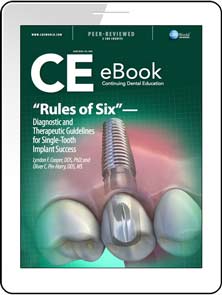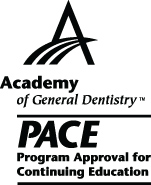CDEWorld > eBooks > “Rules of Six”—Diagnostic and Therapeutic Guidelines for Single-Tooth Implant Success


ADA CERP is a service of the American Dental Association to assist dental professionals in identifying quality providers of continuing dental education. ADA CERP does not approve or endorse individual courses or instructors, nor does it imply acceptance of credit house by boards of dentistry. Concerns or complaints about a CE provider may be directed to the provider or to ADA CERP at www.ada.org/cerp/

Approved PACE Program Provider. FAGD/MAGD credit. Approval does not imply acceptance by a state or provincial board of dentistry, or AGD endorsement. 1/1/2023 to 12/31/2028. ID # 209722.
eBook
Released: Wednesday, July 6, 2016
Expires: Sunday, June 30, 2019
“Rules of Six”—Diagnostic and Therapeutic Guidelines for Single-Tooth Implant Success
By Lyndon F. Cooper, DDS, PhD; and Oliver C. Pin-Harry, DDS, MS
Commercial Supporter: ids-integrated dental systems
Replacing a single anterior tooth with an implant requires meeting a number of interdependent challenges, including biologic, functional, and esthetic. The principles of osseointegration, the fundamentals of esthetics, and concerns regarding occlusion and function are elements that need to be addressed to achieve implantsupported crown success. In this report, the “Rules of Six” for effectively placing a simple single-tooth dental implant are described. These rules represent four diagnostic targets and a single therapeutic guideline useful in directing clinical success and preventing common complications.
LEARNING OBJECTIVES:
-
Explain the functions of a single anterior dental implant
-
Describe the components of the “Rules of Six” for successfully placing a singletooth implant
-
Discuss anatomic situations that may reduce the mesiodistal dimension needed
About the Authors
Lyndon F. Cooper, DDS, PhD
Stallings Distinguished Professor, Department of Prosthodontics, University of North Carolina School of Dentistry, Chapel Hill, North Carolina
Oliver C. Pin-Harry, DDS, MS
Adjunct Assistant Professor, Department of Prosthodontics, University of North Carolina School of Dentistry, Chapel Hill, North Carolina; Private Practice, Ontario, Canada


